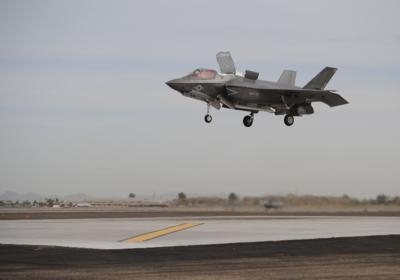Mon, Mar 25, 2013
First STOVL Flight Outside The Test Environment
The Marine Corps’ first operational F-35B Lightning II squadron conducted its first Short Take Off, Vertical Landing operations aboard Marine Corps Air Station Yuma, AZ, Thursday. Maj. Richard Rusnok, an F-35B Lightning II test pilot, conducted Marine Fighter Attack Squadron 121 (VMFA)-121’s first short landing and takeoff as well as the Corps’ first F-35B hover and vertical landing outside of a testing environment in BF-19.

VMFA-121 is the first F-35B squadron to join Marine Aircraft Group 13 which is currently composed of four AV-8B Harrier squadrons a Marine wing support squadron and a Marine aviation logistics squadron. Rusnok was accompanied by VMFA-121's commanding officer, Lt. Col. Jeffrey Scott, flying a second F-35B as a chase aircraft. "The first STOVL flight for an F-35B outside of the test environment was another milestone achieved by the Marine Corps and the Green Knights today here at MCAS Yuma," stated Scott. "The F-35 program and specifically the F-35B have made significant progress to make this possible."
As the squadron expands its operations and end strength, they will continue revolutionizing expeditionary Marine air-ground combat power in all threat environments through the use of MCAS Yuma training ranges in Arizona and California. VMFA-121 will be home to approximately 300 Marines and is expected to receive additional F-35s throughout the next 8 to 12 months, with a total of 16 aircraft scheduled to arrive by late 2013.
Differently from previous fixed wing capabilities across the Department of Defense, the integration of U.S. Air Force, U.S. Navy, U.S. Marine Corps and coalition F-35 Lightning II aircraft on a common platform will provide the dominant, multi-role, fifth generation capabilities needed across the full spectrum of combat operations to deter potential adversaries and enable future aviation power projection.
Specific to the Marine Corps, consolidating three aircraft, the AV-8B Harrier, the F/A-18 Hornet and the EA-6B, into one is central to maintaining tactical aviation affordability and serving as good stewards of taxpayer dollars.
VMFA-121 will continue to set the pace for the F-35 program based on a common platform. The U.S. Air Force and Navy can now integrate best practices from VMFA-121 in preparation for the future operational basing of the F-35A and F-35C.
(Image provided by the U.S. Marine Corps)
More News
Aero Linx: Model Aeronautical Association of Australia MAAA clubs are about fun flying, camaraderie and community. For over 75 years, the MAAA has been Australia’s largest fl>[...]
Touchdown Zone Lighting Two rows of transverse light bars located symmetrically about the runway centerline normally at 100 foot intervals. The basic system extends 3,000 feet alon>[...]
“Discovery and innovation are central to our mission at Virgin Galactic. We’re excited to build on our successful record of facilitating scientific experiments in subor>[...]
How To Get A Story On Aero-TV News/Feature Programming How do I submit a story idea or lead to Aero-TV? If you would like to submit a story idea or lead, please contact Jim Campbel>[...]
Student Pilot Reported That During Rotation, “All Of A Sudden The Back Of The Plane Kicked To The Right..." Analysis: The student pilot reported that during rotation, “>[...]
 ANN's Daily Aero-Linx (05.02.24)
ANN's Daily Aero-Linx (05.02.24) ANN's Daily Aero-Term (05.02.24): Touchdown Zone Lighting
ANN's Daily Aero-Term (05.02.24): Touchdown Zone Lighting Aero-News: Quote of the Day (05.02.24)
Aero-News: Quote of the Day (05.02.24) ANN FAQ: Contributing To Aero-TV
ANN FAQ: Contributing To Aero-TV NTSB Final Report: Cirrus Design Corp SR20
NTSB Final Report: Cirrus Design Corp SR20



